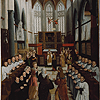Embodied Piety: Sacrament Houses and Iconoclasm in the Sixteenth-Century Low Countries
DOI:
https://doi.org/10.18352/bmgn-lchr.10178Keywords:
Iconoclastic Fury, Iconoclasm, History, Low Countries, BelgiumAbstract
On the eve of the Beeldenstorm, a great number of churches in the Low Countries had a sacrament house, a shrine for the Corpus Christi, often metres high. These monstrance-like tabernacles were nearly all destroyed by iconoclasts between 1566 and 1585. This essay discusses the dialectics between the construction and destruction of sacrament houses before and after the Beeldenstorm.
It argues against a strict divide between material devotion and spiritual belief by highlighting the intertwining of Catholic and Calvinist embodied pieties. Fuelled by their opposing conceptions of the Eucharist, Catholic devotees and Protestant iconoclasts both engaged with sacrament houses and other expressions of the Corpus Christi devotion (processions, miracle cults et cetera) in a deliberate and intensely physical manner.
This article is part of the special issue 'Beeldenstorm'.
Aan de vooravond van de Beeldenstorm stond in heel wat kerken in de Nederlanden een sacramentshuis, een vaak metershoge toren met het uiterlijk van een reusachtige monstrans, waarin het Corpus Christi werd tentoongesteld. Deze tabernakels werden haast allemaal vernield door iconoclasten tussen 1566 en 1585. Dit artikel bestudeert het samenspel tussen het optrekken en afbreken van sacramentshuizen voor en na de Beeldenstorm.
De centrale stelling luidt dat we af moeten van een strikte scheiding tussen materiële devotie en spiritueel geloof. Zowel katholieken als calvinisten beleefden hun geloof op een belichaamde manier en hun handelingen waren steeds verweven. Vrome katholieke leken en protestantse beeldenstormers hadden sterk conflicterende ideeën over de eucharistie, maar juist daarom gingen ze op een heel bewuste en uiterst lichamelijke manier om met de sacramentshuizen en andere uitingen van sacramentsvroomheid zoals ommegangen en mirakelcultussen.
Dit artikel maakt deel uit van het themanummer 'Beeldenstorm'.
Downloads

Published
Issue
Section
License
Authors who publish with this journal agree to the following terms:
a) Authors retain copyright and grant the journal right of first publication with the work simultaneously licensed under a Creative Commons Attribution 4.0 International (CC BY 4.0) that allows others to share the work with an acknowledgement of the work's authorship and initial publication in this journal.
b) Authors are able to enter into separate, additional contractual arrangements for the non-exclusive distribution of the journal's published version of the work (e.g., post it to an institutional repository or publish it in a book), with an acknowledgement of its initial publication in this journal.
c) Authors are permitted to post their work online (e.g., in institutional repositories or on their website) prior to and during the submission process.
Authors are explicitly encouraged to deposit their published article in their institutional repository.







